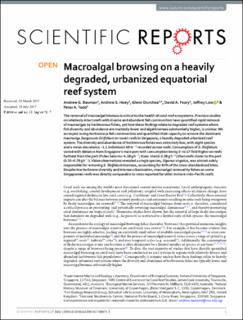| dc.contributor.author | Bauman, Andrew G | |
| dc.contributor.author | Hoey, Andrew | |
| dc.contributor.author | Dunshea, Glenn | |
| dc.contributor.author | Feary, David A. | |
| dc.contributor.author | Low, Jeffery | |
| dc.contributor.author | Todd, Peter A. | |
| dc.date.accessioned | 2020-04-16T13:57:20Z | |
| dc.date.available | 2020-04-16T13:57:20Z | |
| dc.date.created | 2020-04-15T12:24:06Z | |
| dc.date.issued | 2017 | |
| dc.identifier.citation | Scientific Reports. 2017, 7 | en_US |
| dc.identifier.issn | 2045-2322 | |
| dc.identifier.uri | https://hdl.handle.net/11250/2651353 | |
| dc.description.abstract | The removal of macroalgal biomass is critical to the health of coral reef ecosystems. Previous studies on relatively intact reefs with diverse and abundant fish communities have quantified rapid removal of macroalgae by herbivorous fishes, yet how these findings relate to degraded reef systems where fish diversity and abundance are markedly lower and algal biomass substantially higher, is unclear. We surveyed roving herbivorous fish communities and quantified their capacity to remove the dominant macroalga Sargassum ilicifolium on seven reefs in Singapore; a heavily degraded urbanized reef system. The diversity and abundance of herbivorous fishes was extremely low, with eight species and a mean abundance ~1.1 individuals 60 m−2 recorded across reefs. Consumption of S. ilicifolium varied with distance from Singapore’s main port with consumption being 3- to 17-fold higher on reefs furthest from the port (Pulau Satumu: 4.18 g h−1; Kusu Island: 2.38 g h−1) than reefs closer to the port (0.35–0.78 g h−1). Video observations revealed a single species, Siganus virgatus, was almost solely responsible for removing S. ilicifolium biomass, accounting for 83% of the mass-standardized bites. Despite low herbivore diversity and intense urbanization, macroalgal removal by fishes on some Singaporean reefs was directly comparable to rates reported for other inshore Indo-Pacific reefs. | en_US |
| dc.language.iso | eng | en_US |
| dc.publisher | Nature Research | en_US |
| dc.rights | Navngivelse 4.0 Internasjonal | * |
| dc.rights.uri | http://creativecommons.org/licenses/by/4.0/deed.no | * |
| dc.title | Macroalgal browsing on a heavily degraded, urbanized equatorial reef system | en_US |
| dc.type | Peer reviewed | en_US |
| dc.type | Journal article | en_US |
| dc.description.version | publishedVersion | en_US |
| dc.source.volume | 7 | en_US |
| dc.source.journal | Scientific Reports | en_US |
| dc.identifier.doi | 10.1038/s41598-017-08873-3 | |
| dc.identifier.cristin | 1806330 | |
| dc.description.localcode | Open Access This article is licensed under a Creative Commons Attribution 4.0 International License, which permits use, sharing, adaptation, distribution and reproduction in any medium or format, as long as you give appropriate credit to the original author(s) and the source, provide a link to the Creative Commons license, and indicate if changes were made. The images or other third party material in this article are included in the article’s Creative Commons license, unless indicated otherwise in a credit line to the material. If material is not included in the article’s Creative Commons license and your intended use is not permitted by statutory regulation or exceeds the permitted use, you will need to obtain permission directly from the copyright holder. To view a copy of this license, visit http://creativecommons.org/licenses/by/4.0/. | en_US |
| cristin.ispublished | true | |
| cristin.fulltext | original | |
| cristin.qualitycode | 1 | |

